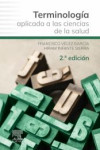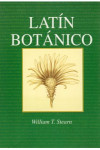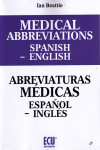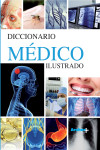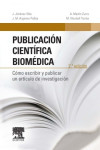MEDICAL AND SCIENTIFIC ENGLISH + EBOOK
Jacopo D'Andria Ursoleo,Kate Gralton
Datos técnicos
- ISBN 9788411062787
- Año Edición 2024
- Páginas 269
- Encuadernación Tapa Blanda
- Idioma Inglés
Sinopsis
Es un recurso nuevo para enseñar y aprender inglés con el fin de aplicarlo en un entorno médico.
Contiene 13 unidades didácticas, cada una de ellas enfocada en una especialidad médica. Las unidades incluyen una serie de actividades para reforzar el aprendizaje del idioma.
Posee un atlas visual del cuerpo humano con las estructuras anatómicas en inglés.
La versión digital cuenta con las pistas de audio en inglés referidas a las actividades y una serie de ejercicios adicionales.
Permite el acceso a la plataforma Voicebooks, una herramienta complementaria para mejorar las habilidades de escucha y comprensión en inglés.
En la era de la globalización, el inglés se ha establecido como un idioma indispensable y predominante en la comunicación científica y médica a nivel internacional. Gran parte de las investigaciones, estudios y actualización de protocolos se publican en inglés, por lo que dominar la lengua permitirá a los profesionales mantenerse actualizados con los últimos avances y prácticas en su campo.
La versión digital de esta publicación incluye material complementario que facilitará la comprensión del contenido de la obra.
Cuenta con:
Audios que ayudan al estudiante a desarrollar sus habilidades en la escucha del inglés médico y que están relacionados con:
Ejercicios propios de las lecciones.
Ejercicios para la preparación de exámenes oficiales de Cambridge Assessment English.
Ejercicios adicionales a los incluidos en la obra impresa, y sus soluciones.
Acceso a Voicebooks : plataforma con 13 unidades alineadas con el contenido teórico del libro. Escucha una frase, escribe en la plataforma lo que entiendas y la plataforma te ayudará a reconstruir la oración completa palabra por palabra. De esta forma evaluarás tus habilidades de escucha y descodificación de las palabras.
Índice
UNIT 1 MEDICAL LANGUAGE AND INTRODUCTION TO THE HUMAN BODY
LESSON 1 Welcome to medical English!
The history of medical English
Communicating with patients in English
Spelling
Pronunciation
LESSON 2 Word structure in medical English
Word structure in medical English
Word roots
Prefixes
Suffixes
Combining words
Abbreviations
EXERCISES Lesson 1
Lesson 2
LESSON 3 Talking about the body
Introduction
Body planes and directions
Frontal or Coronal plane
Sagittal plane
Transverse plane
Other body directions
Body quadrants
Body cavities
LESSON 4 Medical specialties
Medical specialties
Orthopaedics
Dentistry
Pulmonology
Cardiology
Gastroenterology
Dermatology
Haematology
Immunology
Neurology
Endocrinology
Andrology
Gynaecology and Obstetrics
Ophthalmology
Otolaryngology
EXERCISES Lesson 3
Lesson 4
UNIT 2 ORTHOPAEDICS (I): THE SKELETAR SYSTEM
LESSON 1 The anatomy of the skeletal system – the axial skeleton
Introduction
The skull
The bones of the chest
Bones of the back
LESSON 2 The anatomy of the skeletal system – the appendicular skeleton
Pectoral girdle – bones of the shoulders
Upper Extremities
Upper and lower arm
Bones of the wrist, hand and fingers
Bones of the hips
Bones of the lower extremities
Upper and lower leg
Ankles, feet and toes
Physiology of bone growth
EXERCISES Lesson 1
Lesson 2
LESSON 3 The most common diseases and disorders of the skeletal system
The main diseases of the bones and skeleton
Diseases of the vertebrae
Diseases of the joints (arthropathy) and ligaments
Arthritis
LESSON 4 The main diagnostic procedures and treatment of the skeletal system
Laboratory and diagnostic procedures
Blood tests
Imaging tests
Medical procedures
EXERCISES Lesson 3
Lesson 4
UNIT 3 ORTHOPAEDICS (II): THE MUSCULAR SYSTEM
LESSON 1 The anatomy of the muscular system (Part 1)
Types of muscles
Naming of the skeletal muscles
Origins and insertions
Joints
Muscle movement
LESSON 2 The anatomy of the muscular system (Part 2)
Muscles of the head and neck
Muscles of the shoulder, chest and back
Muscles of the upper extremity – arms and hands
Muscles of the abdomen
Muscles of the Lower Extremity – Legs and Feet
Physiology of muscle contraction
EXERCISES Lesson 1
Lesson 2
LESSON 3 The main diseases and disorders of the muscular system
The most common diseases of the muscles
Movement disorders
LESSON 4 The main diagnostic procedures and treatment
The most common laboratory and diagnostic procedures
Blood tests
Muscle tests
The most common medical procedures
Braces and adaptive devices
Deep tendon reflexes (DTR)
Muscle strength test
Rehabilitation exercises
Trigger point injections
Surgical procedures
EXERCISES Lesson 3
Lesson 4
UNIT 4 ODONTOLOGY AND DENTISTRY
LESSON 1 Dental anatomy and physiology
The oral cavity
The teeth
LESSON 2 Dental charting
Introduction
Names of teeth
Dentition
Dental arches
Tooth numbering systems
Tooth surfaces
Morphology of teeth
Occlusion
EXERCISES Lesson 1
Lesson 2
LESSON 3 Dental instruments
Introduction
Hand cutting instruments
Amalgam carriers, condensers, plastic filling instruments, carvers and burnishers
Dental handpieces and rotary instruments
LESSON 4 Dental caries and periodontal disease
Dental caries
Restoration/filling procedure
Periodontal disease
Other forms of periodontal disease
EXERCISES Lesson 3
Lesson 4
UNIT 5 PULMONOLOGY AND THE RESPIRATORY SYSTEM
LESSON 1 The lungs and the respiratory system
The anatomy of the upper respiratory system
The nose and nasal cavity
Pharynx
Larynx
The anatomy of the lower respiratory system
Trachea
Bronchi
Alveoli
The lungs
LESSON 2 Physiology of respiration
Introduction
Respiration
The processes of respiration
Respiratory rate
EXERCISES
Lesson 1
Lesson 2
LESSON 3 The main diseases of the respiratory system
Introduction
Diseases of the upper respiratory system
Diseases of bronchial tubes
Diseases of the lungs
LESSON 4 The main diagnostic procedures and treatment
Diagnostic procedures
EXERCISES Lesson 3
Lesson 4
UNIT 6 CARDIOLOGY AND THE VASCULAR SYSTEM
LESSON 1 The heart and the cardiovascular system
Introduction
The anatomy of the heart
The cardiovascular system
The wall of the heart
LESSON 2 Blood vessels
Introduction
Arteries, capillaries and veins
EXERCISES Lesson 1
Lesson 2
LESSON 3 Circulation of the blood and physiology of the heart
Systemic circulation
Pulmonary circulation
Alveoli
The beating heart: blood pressure
How does the heart pump?
The main cardiovascular diseases, diagnostic procedures and treatment
Introduction
Diagnosis
Treatment for cardiovascular diseases
EXERCISES Lesson 3
Lesson 4
UNIT 7 GASTROENTEROLOGY AND THE DIGESTIVE SYSTEM
LESSON 1 The anatomy and physiology of the upper gastrointestinal system
Introduction
The upper gastrointestinal system
LESSON 2 The anatomy and physiology of the lower gastrointestinal system
The small intestine
The large intestine
Accessory organs of the digestive system
EXERCISES Lesson 1
Lesson 2
LESSON 3 The main diseases of the digestive system
Diseases and disorders
Pharynx and oesophagus
Stomach
Small and large intestines
Inflammatory bowel disease (IBD)
Accessory Organs
LESSON 4 The main diagnostic procedures and treatment
Diagnostic procedures
Blood tests
Gastric and fecal specimen tests
Diagnostic tests
X-ray exams and imaging
Main therapeutic and surgical procedures
EXERCISES Lesson 3
Lesson 4
UNIT 8 DERMATOLOGY AND THE INTEGUMENTARY SYSTEM
LESSON 1 The integumentary system
Introduction
The layers of the skin
Epidermis
Dermis
Hypodermis
LESSON 2 Accessory structures of the skin
Introduction
Hair
Nails
Sebaceous (oil) glands
Sweat glands
EXERCISES Lesson 1
Lesson 2
LESSON 3 The main cutaneous diseases
Introduction
The most common contagious diseases
LESSON 4 The main diagnostic procedures and treatment
Introduction
Diagnostic procedures
Culture and sensitivity test (C&S)
Biopsy
Wood’s Lamp
Scratch (epicutaneous) or Prick Test
Sweat Test
Medical and surgical procedures
Aesthetic procedures
Blepharoplasty
Botox injections
Dermal fillers
Liposuction
Skin resurfacing techniques
Rhytidectomy
EXERCISES Lesson 3
Lesson 4
UNIT 9 HAEMATOLOGY AND INMUNOLOGY
LESSON 1 The anatomy of blood
Introduction
Blood
Plasma
The formed elements
Blood types
LESSON 2 The lymphatic and immune systems
The lymphatic system
Lymph or lymphatic fluid
LymPhatic vessels
Lymphoid tissues – cells and organs
The immune system and immune response
EXERCISES Lesson 1
Lesson 2
LESSON 3 The main diseases of the blood and lymphatic system
The most common diseases of the blood
Anaemia
Deep vein thrombosis (DVT)
Haemophilia
Leukaemia
Mononucleosis
Multiple myeloma
Polycythemia vera
Thallassemia
Transfusion reaction
The most common diseases of the lymphatic system
Graft-versus-host disease (GVHD)
Lymphadenopathy
Lymphoedema
Lymphoma
Thymoma
Vasculitis
The most common immune disorders
LESSON 4 The main diagnostic procedures and treatment
Introduction
Blood tests
Blood type
Blood culture and sensitivity (C&S)
Complete blood count (CBC)
Erythrocyte sedimentation rate (ESR, SR, Sed rate)
Peripheral blood smear
Coagulation tests
Serum tests
Urine tests
Other blood tests
Diagnostic Imaging
The most common medical procedures
The most common surgical procedures
EXERCISES Lesson 3
Lesson 4
UNIT 10 NEUROLOGY AND THE NERVOUS SYSTEM
LESSON 1 The Anatomy of the Central and Peripheral Nervous Systems
Introduction
The Anatomy of the Central Nervous System (CNS)
The Brain
The Spinal Cord
The Peripheral Nervous System (PNS)
The Somatic Nervous System
The Autonomic Nervous System
LESSON 2 Physiology of a Neuron and Neuron Transmitters
Nervous Tissue
EXERCISES Lesson 1
Lesson 2
LESSON 3 The Most Common Diseases of the Nervous System
The Main Neurological Diseases and Disorders
Amnesia
Aphasia
Arteriovenous Malformation (AVM)
Brain Tumor
Cephalalgia
Cerebral Palsy
Cerebrovascular Accident (CVA)
Coma
Concussion
Dementia
Encephalitis
Epilepsy
Huntington’s Disease
Meningitis
Parkinson’s Disease
Spinal Cord Injury
Multiple Sclerosis
LESSON 4 The Main Diagnostic Procedures and Treatment
Introduction
Laboratory Tests
Cerebrospinal Fluid Examination (CFS)
Imaging Tests
Cerebral Angiography
Computed Axial Tomography (CAT, CT)
Doppler Ultrasonography
Magnetic Resonance Imaging (MRI)
Myelography
Positron Emission Tomography Scan (PET)
Skull X-ray
Other Diagnostic Tests
Electro Encephalography (EEG)
Evoked Potential Testing
Nerve Conduction Study
The Most Common Medical and Surgical Procedures
Babinski’s Sign
Glasgow Coma Scale
Lumbar Puncture
Mini-Mental Status Examination (MMSE)
Neurologic Examination
Spinal Traction
Transcutaneous Electrical Nerve Stimulation (TENS) Unit
Specific Surgical Procedures
Carotid Endarterectomy
Discectomy
Stereotactic Neurosurgery
Ventriculoperitoneal Shunt
EXERCISES Lesson 3
Lesson 4
UNIT 11 ENDOCRINOLOGY AND THE ENDOCRINE SYSTEM
LESSON 1 The Anatomy of the Endocrine System
Introduction
The Anatomy of the Endocrine System
Hypothalamus
Pituitary Gland
Pineal Gland
Thyroid Gland
Parathyroid Glands
Thymus Gland
Pancreas
Adrenal Glands
Ovaries
Testes
LESSON 2 Physiology of Hormones
Hormone Response and Feedback
EXERCISES Lesson 1
Lesson 2
LESSON 3 The Main Diseases and Disorders
of the Endocrine System
Introduction
Hyperadrenalism and Hypoadrenalism
Hypercalcemia and Hypocalcemia
Hyperthyroidism
Hypothyroidism
Pancreatitis
Pituitary Gigantism
LESSON 4 The Main Diagnostic Procedures
and Treatment
Laboratory and Diagnostic Procedures
Blood Tests
Urine Tests
Imaging Tests
EXERCISES Lesson 3
Lesson 4
UNIT 12 ANDROLOGY, GYNAECOLOGY, AND OBSTETRICS
LESSON 1 The Anatomy and Physiology of the Male Reproductive System
Introduction
External Organs
Internal Organs
Physiology of Spermatogenesis and Ejaculation
Spermatogenesis
Ejaculation
LESSON 2 The Anatomy and Physiology of the Female Reproductive System
Introduction
Internal Organs
External Genitalia
Menstrual Cycle
Pregnancy
Labour and Delivery
EXERCISES Lesson 1
Lesson 2
LESSON 3 The Main Diseases and Disorders of the Male Reproductive System, Diagnostic Procedures and Treatment
Introduction
Testes and Epididymis
Prostate
Penis
Sexually Transmitted Diseases (STD)
The Most Common Laboratory and Diagnostic Procedures
Blood Tests
Semen Tests
Diagnostic Imagery
LESSON 4 The Main Diseases and Disorders of the Female Reproductive System, Diagnostic Procedures and Treatment
Ovaries and Uterine Tubes
Menstrual Disorders
Cervix
Vaginal Infections
Breasts
Sexually Transmitted Disease (STD)
Pregnancy, Labour and Delivery
During Pregnancy
During Labour and Delivery
The Most Common Laboratory and Diagnostic Procedures
Gynaecological Tests
Diagnostic Imagery
EXERCISES Lesson 3
Lesson 4
UNIT 13 OPHTHALMOLOGY AND OTOLARYNGOLOGY
LESSON 1 The Anatomy and Physiology of the Eye
Introduction
The Anatomy of the Eye
Physiology of Vision
LESSON 2 The Anatomy and Physiology of the Ear
Introduction
Anatomy of the Auditory System
Vestibule and Semicircular Canals
Cochlea
Physiology of the Sense of Hearing
EXERCISES Lesson 1
Lesson 2
LESSON 3 Diseases, Disorders, Diagnostic Procedures and Treatment in Ophthalmology
Refractive Disorders
Inflammation and Infection
Pathologies
LESSON 4 Diseases, Disorders, Diagnostic Procedures and Treatment in Otolaryngology
The Main Diseases and Disorders of the Ear
Hearing Loss
The Main Diagnostic and Surgical Procedures
Diagnostic Tests
EXERCISES Lesson 3
Lesson 4
Otros libros que te pueden interesar
- ¿Quiénes somos?
- Gastos de envío
- Política de privacidad
- Políticas de devolución y anulación
- Condiciones Generales de contratación
- Contacto
2025 © Vuestros Libros Siglo XXI | Desarrollo Web Factor Ideas






